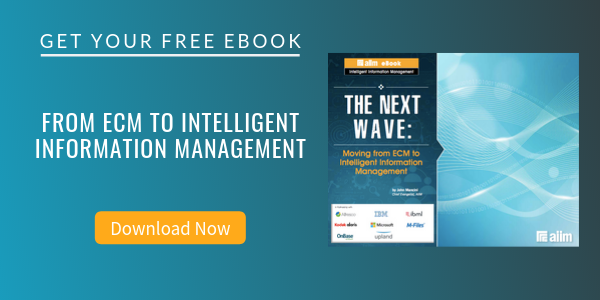
From Jurassic Park to Digital Transformation: A Tale of Information Professionals
Intelligent Information Management (IIM)
It is literally 20 years to the day since I first started at AIIM. I've been thinking about how the technology landscape has changed since I first walked on the scene at AIIM and what the implications of these changes are for how we think about what it means to be an “Information Professional." This was the heart of what I spoke about during my keynote at The AIIM Conference, and we've now published as a new e-book.
How We Got Here
Slate.com did a good article a while back talking about how much technology has changed since 1996. They used the term “Jurassic Web” to describe 1996, and I rather like that characterization.

So let's think a little bit about what 1996 looked like:
- Only 20 million American adults had access to the internet.
- Something called “a blog” was still three years away.
- 99% of phone users did not find text messaging to be of any use whatsoever -- assuming they even knew what it was.
- The first iPhone was still 11 years away. That’s right, 11 years in the future.
- Microsoft Office 97 was published in December on CD-ROM but also - get this - on a set of 45 (forty-five!) 3.5 inch floppy disks.
In 1996 there was no YouTube. No Huffington Post. No Google. No Twitter. No Facebook. And no Wikipedia.
In 1996, AIIM was also in what I would call the pre-web phase of its existence. One month before I joined AIIM, the association's magazine, INFORM, had this quote:
“Despite the area of Internet enthusiasm and the hyped-up selling palaver of some web services providers, we remain uncertain as to the long run substitute benefits the internet will bring to businesses and to individual users.”
Oops.
As Yogi would say, “It's tough to make predictions, especially about the future.” I'm especially glad that this AIIM prediction was before my time.
How did AIIM Survive for all of these years?
So that's the backdrop for the past 20 years. Of course, against this, AIIM goes back even further. Many people do not realize that AIIM was founded in 1943 as the National Microfilm Association. Many people are mystified about how an organizational journey could somehow begin in 1943 with microfilm, and wind up in 2016 with content and information management.
So what is the connective tissue in this strange story?
I think it boils down to 3 words.
People. Process. Technology.
Leaning into the Future
Here's the keynote deck in case you missed it. Socialize it and share it if you are so inclined.
About John Mancini
John Mancini is the President of Content Results, LLC and the Past President of AIIM. He is a well-known author, speaker, and advisor on information management, digital transformation and intelligent automation. John is a frequent keynote speaker and author of more than 30 eBooks on a variety of topics. He can be found on Twitter, LinkedIn and Facebook as jmancini77. Recent keynote topics include: The Stairway to Digital Transformation Navigating Disruptive Waters — 4 Things You Need to Know to Build Your Digital Transformation Strategy Getting Ahead of the Digital Transformation Curve Viewing Information Management Through a New Lens Digital Disruption: 6 Strategies to Avoid Being “Blockbustered” Specialties: Keynote speaker and writer on AI, RPA, intelligent Information Management, Intelligent Automation and Digital Transformation. Consensus-building with Boards to create strategic focus, action, and accountability. Extensive public speaking and public relations work Conversant and experienced in major technology issues and trends. Expert on inbound and content marketing, particularly in an association environment and on the Hubspot platform. John is a Phi Beta Kappa graduate of the College of William and Mary, and holds an M.A. in Public Policy from the Woodrow Wilson School at Princeton University.



